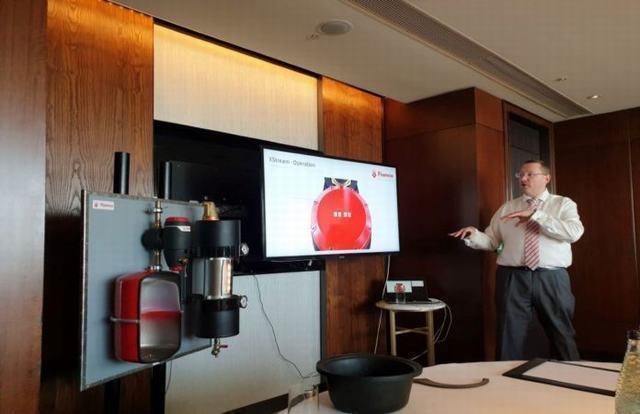October Newsletter 2019
October 2019 Newsletter
‘Viessmann launches new 11KW output system boiler, £250m funding for museums and culture projects, UK renewables generate more electricity than fossil fuels for the first time, Contest for £500m decarbonisation framework’.
Quick Links
Viessmann launches new 11KW output system boiler
Viessmann is introducing what it claims is the UK’s lowest output system boiler as part of its new Vitodens 200 domestic boiler range.
The new 11kW Vitodens 200-W responds to demand from installers for system boilers that closely match the heat demand of the majority of modest-sized, well-insulated homes.
“Not many homes have a heat load of more than 10kW, yet most system boiler ranges start at an output of around 19kW. This means that the majority of system boilers in the UK are oversized,” explains Viessmann Marketing Director, Darren McMahon.
“Homeowners are buying larger boilers than they need and once installed, the boiler cycles more than it needs to, increasing running costs and wear and tear. A correctly-sized boiler will be more efficient and last longer.
“The Vitodens 200-W 11kW model means installers no longer have to ‘range rate’ larger boilers. System boilers can now be fitted where heat-only models may have been chosen previously. The boiler has a higher heat output rating of 17kW for the generation of hot water, so there is no trade-off between space and DHW heat.”
The Viessmann Vitodens 200 gas-condensing boilers are arriving in UK merchants this month. They are available as a wall-hung boiler (Vitodens 200-W) and floor-standing storage boiler (Vitodens 222-F), with outputs from 11kW to 60kW.

Viessmann launches new 11KW output system boiler
Source: HVP Magazine
UK Construction week survey reveals half of construction industry suffering with mental health issues
The largest event in the history of the UK construction industry to address mental health issues in the sector opens today (Tuesday 8 October), as part of UK Construction Week.
The focus on mental health and wellbeing at this year’s show is in response to the latest research results which paint a picture of an industry that desperately wants more mental health support.
The most recent survey conducted last month on behalf of UK Construction Week revealed that over half of people in the construction industry have suffered mental health problems at one point in their lives.
Six out of 10 people (58%) working in construction have suffered from mental health problems due to their work, most often stemming from financial issues (45%), long hours (41%) and the physical strain of the job (41%). Despite this, only four out of 10 (44%) have actually spoken out about it at work – and this figure rises to 71% for those aged over 55.
Over a third of respondents (37%) admitted that they had taken time off work due to their mental health, with only 64% of those telling their employer the reason why. The problem is particularly acute among the 18-34 age group.
When asked who they would turn to if they were to experience any mental health issues, most construction professionals felt they would be most comfortable talking to a dedicated mental healthcare professional (30%), followed by someone who they get on well with at work (27%). A chat with a friend is considered the most effective mood-booster for a bad day at work, according to respondents (50%), followed by music (46%), exercise (38%) and food (32%).
However, most importantly, over half of all respondents (56%) felt there was more their organisations could be doing to support the mental health of workers. Of the support services that they thought would be most beneficial, top of the list was free counselling (39%) or flexible working (39%), followed by a dedicated trained person to speak to (35%), an on-site quiet space (27%), and an anonymous helpline (24%).
Interestingly, there were differences between men and women in the industry about what was needed most. Women are more likely to prefer allocated wellbeing days (30% vs 17%), an on-site quiet space (34% vs 24%), and flexible working (52% vs 35%) when it comes to tackling their mental health at work. Men are more likely to prefer anonymous helplines (26% vs 21%).
Some of these support services are provided by the mental health charities working in the construction industry, including Mates in Mind and the Lighthouse Club’s Construction Industry Helpline.
Nathan Garnett, event director at UK Construction Week, said: “Awareness about the importance of mental health has grown throughout the construction industry in recent years. However, the industry still has a way to go in normalising open discussion about this aspect of health and wellbeing. That’s why we put together the Wellbeing Zone at this year’s UK Construction Week. We’re using the country’s largest construction event to host the industry’s biggest discussion and support initiative on mental health, swapping hard hats for hard chats. Through signposting to counselling, free employer advice and the simple sharing of stories, right through to yoga and meditation sessions, exercise and sporting challenges, this year’s UK Construction Week is designed to help as many people as possible, culminating on Thursday 10 October to celebrate World Mental Health Day.”
Wellbeing features at UK Construction Week include:
- An installation of relaxing swings made by master craftsman Carwyn Jones, in a Wellbeing Zone full of advice and information on mental health support run in association with the NHS’s new Every Mind Matters initiative.
- The launch of the Mind Your Head campaign, which features a ‘Material Support’ gallery, a collection of artwork made from construction components. There will be mental health experts who work in construction and practical advice available from an onsite therapist.
- A multi-sports tournament and cup involving football, netball and touch rugby, organised with STEAM, a mental health charity which promotes wellbeing in construction through sport and exercise.
- Free yoga and meditation sessions every morning of the show.
- Free advice workshops for employers in the Working Well Together Theatre , including sessions on how to manage the issue of alcohol and drugs effectively in the workplace and mental health in the workplace – an industry perspective.
UK Construction Week (UKCW) finishes on 10 October, which is World Mental Health Day, so the theme runs strongly throughout the three days.
UKCW is one event with many sections, including Build sponsored by Easy-Trim, Building Tech, Civils, Energy and HVAC, Surface and Materials, and Timber. It also features Concrete Expo (8-9 October only) and Grand Designs Live (9-10 October only). Single registration gives free access to all areas of the show.

UK Construction week survey reveals half of construction industry suffering with mental health issues
Source: Electrical Contracting News
Flamco unveils greener generation of products
Flamco unveiled its Flexcon Premium range of expansion vessels during a launch event at London’s Shard building this week.
The new range, in a variety of sizes, benefits from a new plastic membrane offering raw materials and energy savings, with a 15-year guarantee.
Flamco has developed the membrane for expansion vessels of 2 to 80 litres. It has replaced the vessels’ rubber membrane with a plastic membrane made of thermoplastic polyolefin (TPO) without losing flexibility and permeability properties.
TPO can also be burned or recycled more efficiently into other products of the same quality.
The new membrane is much lighter, because it requires up to 50% less material. This saves raw materials, energy and fuel for transport and results in a large reduction of CO2 emissions, a statement said, while packaging has also been reduced. “With this holistic approach, Flamco has taken a big step towards an even smaller ecological footprint,” it added.
Also during the event, Flamco technical director Rob Clemson, pictured, provided an update on the XStream series of air and dirt separators, launched at the ISH exhibition earlier this year. Sold with a 15-year guarantee, they have integrated insulation and can be rotated for either horizontal or vertical fitting.

Flamco unveils greener generation of products
Source: HPM Magazine
Bureau Veritas issues direct current warning on RCDs
With the 18th Edition of the IET Wiring Regulations including updated guidance on the use of various types of residual current devices (RCDs), Bureau Veritas is warning that a rising number of AC type RCDs are being adversely affected by direct currents (DC) from electronic devices and renewable energy sources.
It comes amid the growing use of RCDs over the years, with AC type RCDs often promoted as the first choice, particularly since 2001 where the 17th Edition (amendment one) directly stated that AC type RCDs should be used for sockets that might supply outdoor equipment.
However, according to electrical safety expert, Bureau Veritas, as more and more homes, commercial and industrial sites are now using electronic equipment and installing renewables such as solar PV, many of these RCDs may well be not fit for purpose – putting an increasing number of people at risk.
Michael Kenyon, Technical Manager at Bureau Veritas, explains, “Modern electrical installations are now, more than ever, incorporating technologies and products that manipulate the current wave forms. These devices such as Solar PV and electric vehicle chargers could be leaking (direct current) back into the electrical system and saturating the iron core of the AC type RCDs which are not designed to handle it.
“This is a particular problem when dealing with poor quality electronic equipment or substandard installations, as DC leakage current can be created by faulty equipment such as solar PV, EV chargers, variable speed drives, and even faulty mobile phone chargers or USB sockets. Inevitably, we’re seeing RCDs being increasingly affected by DC – putting many people at risk.”
As an independent electrical specialist, Bureau Veritas suggests the industry, instead, looks at using A or B type RCDs that are specifically designed to offer protection against alternating and pulsating direct – as stated in the recent rewrite of 531.3 of BS7671.
Kenyon continues, “The rewrite of 531.3 has certainly led to an increased awareness of the different type of RCDs on the market. But in terms of promoting best practice, at the moment, it just doesn’t go far enough in recommending the use of A type RCDs. In fact, regulation (531.3.3) still states that for general purposes, type AC RCDs should be used coupled with disincentive that type A RCDs are still much less readily available.
“From our experience, we’d recommend A type RCDs for general use, although going forward this will need to be supported by regulation, the industry and even manufacturers, as nine out of 10 devices found online were still AC type and the A type devices remain significantly more expensive.
“Specifying the correct RCDs can be a technical and complicated area, and currently there’s a knowledge gap within the electrical industry about the risks of using AC type RCDs in modern installations. That’s why it’s important, now more than ever, to ensure every electrical installation is safe and fit for use – and the best way to do this is through regular testing and inspection.”
Bureau Veritas offers a range of testing and certification services to support customers in managing compliance around electrical safety in general for new and existing installations or for specific areas, such as electric vehicle charging points.

Bureau Veritas issues direct current warning on RCDs
Source: Electrical Contracting News
£250m funding for museums and cultural projects
Cultural projects, libraries, museums and creative industries will get a £250m to deliver expansion projects over the next five years.
York’s National Railway Museum is among the biggest immediate winner. It will receive £18.6m to kickstart £50m transformation plans, including new gallery and exhibition spaces and the restoration of heritage buildings.
The museum will become the cultural hub of vast York Central redevelopment creating up to 2,500 new homes.
Judith McNicol, Director of the National Railway Museum, said: “This is wonderful news for the National Railway Museum – and for the City of York. This £18.6m investment by the Government is an extremely significant milestone in realising our £55m Vision 2025 campaign to turn our museum into a truly world-class attraction.
Coventry also gets an extra £7m to fund its 2021 UK City of Culture programme that will unlock £37m of extra funding and over £107m of tourism impacts.
Elsewhere, £125m will be invested in regional museums and libraries around the country.
More than £90m will be provided to extend the Cultural Development Fund which uses investment in heritage, culture and creativity to drive regeneration and growth.

£250m funding for museums and cultural projects
Source: Construction Enquirer
Middlesbrough plans £250m trio of skyscrapers
Middlesbrough Mayor Andy Preston has unveiled plans to create a £250m digital city in the city’s Boho district.
The plans include building the highest office and residential towers for 30 miles as part of an initial £45m phase of the project that will transform Teesside’s skyline.
Construction of the first phase, which will include three 20 storey-towers, will start next summer and create up to 400 construction jobs.
It will see the creation of a digital campus, a 750-seat indoor amphitheatre beneath a glass atrium and a 400-seat outdoor amphitheatre to host events such as lectures, cultural events and entertainment.
Mayor Preston said: “For the next few years my obsession, my mission, my purpose on this planet is to get Middlesbrough on track as the digital city for the UK.
“This is a £45m first step of a quarter of a billion pounds scheme that will propel Middlesbrough on a journey to become the UK’s digital capital – bringing investment, jobs and prosperity to the town.
“This isn’t another pipe dream that might happen in two, four or ten years’ time. This is happening now.
“We have the money and investors in place. Planning consent will be sought within weeks and construction will start next summer.”
The £30m office element is being joint funded by the Tees Valley Combined Authority and Middlesbrough Council.
This includes £26.5m from the Combined Authority’s £588m Investment Plan which was agreed earlier this year and sets out a ten-year vision to transform the region.
The council will contribute £3.5m, with a further £15m investment in residential accommodation by a third party consortium.

Middlesbrough plans £250m trio of skyscrapers
Source: Construction Enquirer
Contest for £500m decarbonisation framework
Procurement group Fusion 21 is on the hunt for firms for its latest generation national heating and renewables framework.
With a predicted £500m work pipeline over four years, a new lot has been developed with the Department for Education to support schools, academies and colleges with their heating requirements.
The 10-lot framework will select firms offering domestic and commercial solutions as well as offering a range of services from consultancy to design, servicing, maintenance and installation.
The framework also includes a selection of renewable technology applications from air and ground source heat pumps to solar thermal, electric heating and hot water systems.
The commercial element will target district heating systems and the installation/ servicing of heat interface units.
Providing regional coverage, the framework has been structured to open doors to SMEs, enabling suppliers to bid for works suited to their experience and expertise.
Peter Francis, director of operations at Fusion21, said: “With the use of renewable technologies on the rise and a government target to deliver decarbonisation – this framework will also support members to install a range of sustainable heating solutions tailored to their requirements.”
Interest firms can find prequal informatiom on the mytenders web portal under Notice ID OCT158374.
The framework will come into force from the start of 2020.
To date Fusion21 has saved clients an estimated £225m through the procurement process, created 6,500 jobs and generated more than £80m of social impact.

Contest for £500m decarbonisation framework
Source: Construction Enquirer
At what temperatures does the heating go on?
A new study from intelligent home climate management company tado° has found that the further north you live, the more likely you are to tolerate both a colder outdoor and indoor temperature. On average, UK householders first turn on their post-summer heating when the outside temperature drops to 13.5°C, but there’s a difference between Southerners, Northerners, and Scots.
The average outdoor temperature needed to get Southern English people to first turn on their thermostat after the summer is 13.5°C. Northerners wait for it to drop to 13°C, while Scots hold out until the temperature falls to just 12.5°C. The average inside temperature at this time is 20.5°C for Southerners, 20°C for Northerners, and 19.5°C for Scots. As of the second week of October, approximately 95% of Brits had switched their heating on since the summer.
It also seems that we like our homes to be cooler than our European neighbours, with the average yearly temperature in UK homes set at 21°C compared to 22°C in Germany and the Netherlands, 22.5°C in France and Sweden, and 23°C in Spain, Italy, and Norway.

At what temperatures does the heating go on?
Source: PHAM News
UK renewables generate more electricity than fossil fuels for the first time
Energy sector has seen hydrocarbon use halve since 2010 and green sources increase more than fourfold.
UK renewables have generated more electricity than fossil fuels for the first time, according to an analysis of energy use for the third quarter of this year.
Wind farms, solar panels, biomass and hydropower generated 29.5 terawatt hours (TWh) of energy for the months of July, August and September, compared to 29.1TWh from fossil fuels, according to Carbon Brief.
In 2010, 10 times more energy came from burning fossil fuels than renewable energy, but the cost of renewables has tumbled, with onshore wind and solar power frequently cheaper.
This marks the latest milestone in the rapid decarbonisation of the UK’s electricity system.
Dr Simon Evans, deputy editor of Carbon Brief, told The Independent: “The UK has made significant progress in cutting its CO2 emissions over the past decade.
“Almost all of that progress is thanks to the electricity sector, which as our analysis shows has seen fossil fuel generation halve since 2010 and renewables increase more than fourfold.
“Other parts of the economy have made very little progress. The UK will not be able to meet its legally-binding carbon targets in future without emissions cuts in other areas, such as heating and transport,” he said.
This is part of a growing trend and in the first three quarters of this year, renewables did better than fossil fuels on 103 out of 273 of the days.
However, despite huge success in the electricity sector, other parts of the economy have made little progress in reducing emissions.
Last year 6.8tns of greenhouse gases were emitted per person and by 2050 this will need to have dropped to zero.
The Committee on Climate Change’s (CCC) annual report to parliament showed UK action to slash greenhouse gas emissions driving climate change is lagging far behind what is needed.
BEIS was awarded £30m extra in the latest spending round to “accelerate progress” on decarbonisation projects next year.
However, this was just 0.1 per cent of what is required, according to Britain’s biggest environmental groups, including Greenpeace and Friends of the Earth.

UK renewables generate more electricity than fossil fuels for the first time
Source: The Independent
Changes to benchmark commissioning checklist
The Heating and Hotwater Industry Council (HHIC) – in partnership with major boiler manufacturers, installers and representatives from across the supply chain – have revisited the Benchmark scheme to update the commissioning checklist, taking it into 2020 and beyond.
Launched in 1999, the Benchmark scheme is designed to promote quality for the installation, commissioning and servicing of domestic heating and hot water systems. The scheme has been updated to reflect modern day best practice, standards and legislation.
Commenting on the changes, HHIC director Stewart Clements, says: “As a result, there are a few changes you will notice now appearing on recently printed Checklist forms in order to make it more relevant and also to offer further improvements to the overall efficiency of the Benchmark system.
“Completing the Benchmark Checklist is already a means of meeting the commissioning requirements within Part L of the Building Regulations, and embracing Benchmark is the most straightforward way to help make sure you comply, as the documentation is already supplied with the appliance.
“To help make completing the checklist even easier, HHIC are currently investigating whether or not it is possible and feasible to move the form online. This would mean that installers would be able to simply complete the checklist at the same time as registering the installation with Gas Safe, across different manufacturer brands.”
The online system is currently in the design phase and planned for launch by the end of 2020.
Copies of the new Benchmark Checklists and other scheme documents can be found with the installation instructions supplied with products, or it can be seen by visiting www.hhic.org.uk/resources.

Changes to benchmark commissioning checklist
Source: PHAM News
18th Edition – Is it fit for purpose?
Almost a year has passed since the latest update was made to the 18th Edition regulations. However, questions remain as to whether the regulations are still fit for purpose and of value to modern electricians, particularly those working in industrial environments.
Whilst the updates included refreshed guidance around energy efficiency, approved parts, surge protection and arch fault detection, many of the changes had little relevance for electricians in the field and were aimed more at systems designers.
A large number of the updates detailed in the new regulations, for example, those relating to the installation and application of switchgear, could be considered an attempt to ensure that the new guidance accurately reflects the types of products and technology being used in industrial installations.
Ultimately, the updated 18th Edition regulations still constitute an essential source of information and guidance in any modern-day electrician’s toolkit. However, they contain a number of grey areas which are open to interpretation. Take, for example, the use of isolators on motors. According to the updated regulations 135.15.202 “Every fixed electric motor shall be provided with an efficient means of switching off readily accessible, easily operated and so placed as to prevent danger”. If this was taken literally, the installations could have potentially hundreds of motors, each with their own point of isolation nearby. In reality, this approach is neither logical nor feasible.
The regulation does however give the designer an option in that the efficient means of switching off can actually be remote from the motor, providing a safe system of work is in place to prevent danger. A better approach would be to define isolation requirements by current levels and locality to the power source, giving systems designers and industrial electricians more leeway in terms of where crucial isolation points are located.
It must not be forgotten that the 18th Edition regulations are a guide and are intended to be a ‘one size fits all’ approach. However, for younger, less experienced engineers, this can be cause for confusion as they are to some degree, open to interpretation. Newly-qualified electricians or those in training may find themselves faced with problems and situations on site which are not directly referred to by the guidance. In cases such as these, the individual is required to draw on common sense and experience to settle on a workable solution.
Some may argue that the lack of detail contained within the regulations limits their usefulness. However, turning them from ‘guidance’ into ‘rules’ could create further issues. A rule is inherently more prescriptive and considering the extremely diverse nature of industrial electrical applications, it would be a near impossible task to compile a single set of rules which would cover all eventualities.
One area of the 18th Edition regulations where there is clearly room for improvement is around some of the more specific sections, which would benefit for a degree of clarification. For example, there clearer distinctions should be made between the differing requirements for domestic, industrial and commercial installations. Of course, a large amount of the information, for example around earthing requirements, would remain the same. However, having set specifications for electricians working in different environments would be helpful in the long run.
Similarly, more detail should be given in the regulations about ‘Zs’ values, which represent maximum loop fault earth impedance. Currently, only the more commonplace figures are quoted in the 18th Edition, which rarely gives the level of information needed for industrial electricians. As the figures change, rather than waiting for a new edition of the regulations to be published, the amends could be issued as an addendum to the main document.
Lastly, there are some grey areas in the current publication around cable types. There are a number of IEC 60502-1-compliant cables, which are not necessarily coordinated with BS7671, the main UK wiring regulations. However, in the 18th Edition there are several blanket references, suggesting that all IEC 60502-1 cables may be of similar requirement to the British Standard. These parts are stated as informative (Appendix 4.1 for example) so they are not a regulation. Despite being a rather niche point, this distinction is important nonetheless, especially for less experienced electricians and designers in training.
The 18th Edition regulations form an important source of guidance and standardisation for electricians operating in a number of different environments. Whilst turning them from ‘guidance’ into ‘rules’ is not likely to benefit anyone, a number of refinements and clarifications would make them a more powerful and accessible tool for all of the UK’s electricians. Who knows what the 19th Edition may bring?

18th Edition – Is it fit for purpose?
Source: Electrical Times
Start date for £1.4bn London Gotham City offices
The long-delayed 40 Leadenhall Street office scheme in the City of London has finally got a start date.
In a significant vote of confidence in the City, M&G Prudential has salvaged the stalled scheme with plans to invest £875m to buy and build on the site.
Contractor Mace has been in the frame to build the 900,000 sq ft project nicknamed Gotham City for more than 12 months.
Construction will now start early in 2020 once Keltbray completes clearing the key Leadenhall Triangle site to allow building of two stepped towers of 14 and 34 storeys.
The site was sold by Alberta Investment Management Corporation and Nuveen Real Estate, which will continue as development manager.
The new buildings’ carbon emissions will be 30% below current regulations and are expected to achieve a BREEAM Excellent rating.
Tony Brown, global head of M&G Real Estate, said: “London’s commercial property market currently offers good value relative to other capital cities such as Paris and Tokyo, partly due to Brexit-related uncertainty.”
“As there are a limited number of developments underway in London, we expect high-quality office space like this with an emphasis on green credentials and employee well-being to be in demand from occupiers when the scheme is completed in four years.”

Start date for £1.4bn London Gotham City offices
Source: Construction Enquirer
Native Land commits to £1bn London Bankside scheme
Developer Native Land has committed to the first speculative office building at its £1bn Bankside Yards mixed-use development next to Blackfriars Bridge in London.
Demolition and foundations specialist McGee has bagged the contract for the Western Yards basement and concrete core for the initial 230,000 sq ft offices project, known as the Arbor.
Tendering for main contractor is now underway with an award targeted before the end of the year. Mace, Multiplex and Balfour Beatty are among those chasing the job.
The centrepiece of Bankside Yards will be the restoration of 14 historic railway arches set in three acres of newly-created open space.
Native Land and its consortium partners Temasek, HPL and Amcorp Properties have now fully funded the Western Yards first phase, which also includes a residential block of 240 luxury flats with views across the capital.
Western Yards will also create 50,000 sq ft of independent retail, restaurant and cultural space in the restored railway arches.
More than half of the wider 5.5-acre Bankside Yards site will be walkable open space, with extensive greenspace and a sweeping stairway down to the Thames.
When complete the scheme located near the Tate Modern gallery will consist of around 600 homes.
The developer will make a financial contribution of at least £65m to Southwark Council to deliver new affordable housing across the borough.
The overall development will create an estimated 3,600 jobs in the retail, commercial and construction sectors, while providing training and apprenticeships for local job seekers.
Alasdair Nicholls, chief executive of Native Land, said: “We are opening up an important piece of London with amazing transport connections and, as locally-based developers, we are keen to contribute to the rich mix of the area by creating a place that’s accessible, enjoyable and productive.’
Native Land is developing a cultural strategy for Bankside Yards, which will integrate the development’s 20,000 sq ft of new cultural spaces with the wider South Bank and Bankside creative and arts scene.
The second phase of the development, known as Eastern Yards, will include a premier hotel and on-site affordable and private homes.
Bankside Yards is master-planned by PLP Architecture with Gillespies as the landscape architects.

Native Land commits to £1bn London Bankside scheme
Source: Construction Enquirer
Take 2 for Made in Dagenham film studios plan
Barking and Dagenham Council will go-ahead with plans to build a Hollywood-scale film studio in East London, despite its preferred development partner pulling out over Brexit uncertainty.
Pacifica Ventures, the studios where Breaking Bad was made, was preferred bidder for the Made in Dagenham studios.
But according to the council it failed to “progress matters sufficiently” and has lost its preferred bidder status.
Be First, Barking and Dagenham Council’s pioneering regeneration company, will now take on design and seek planning permission for the 20-acre former Sanofi site in Dagenham East.
The Dagenham East studios will provide up to 200 000 sq ft of film stages and workshops alongside creative workspace and food facilities.
Councillor Darren Rodwell, Leader of Barking and Dagenham Council said: “This is the next exciting stage in our ambition to build the largest studios in London for 25 years.
“If we get planning permission to build our Made in Dagenham studios, there are some exciting options – we could build them ourselves or we can work with any of the ambitious dynamic media companies who share our vision of making movies in what will be London’s Hollywood.”
Pat Hayes, Be First’s Managing Director, said: “Pacifica told us they were finding it difficult to deliver their plans due to uncertainty over the UK leaving the European Union.
“But what is not in doubt is the viability and demand for studio space in the UK which remains sky high, and that is why I am convinced there will be plenty of interest from parties who want to make sure movies will be Made in Dagenham.”
After last night’s council decision, Be First will submit a planning application in the New Year.

Take 2 for Made in Dagenham film studios plan
Source: Construction Enquirer



